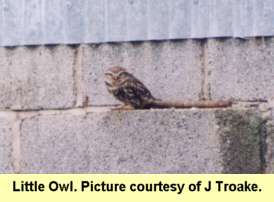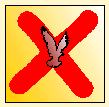
LITTLE OWL. Athene noctua
IDENTIFICATION. The smallest of the UK's owls. The scientific name means 'Goddess of the night', which might not be so apt as Little Owls are generally diurnal.
The plumage is a grey brown, flecked with white spots. The flattened head has light coloured 'eye brows' over yellow eyes, giving this owl a frown like or 'grumpy' expression. Little owls are a favourite prey of Sparrowhawks.
For its size there is no other native owl it can be confused with. However the fluffy grey young may be mistaken for Tawny Owl chicks.
IN FLIGHT. Direct flight is undulating, similar to a woodpeckers. Whilst in flight from the ground to a tree the Little Owl could be mistaken for a thrush.
DISTRIBUTION. The Little Owl was first introduced into Britain from Europe in the late 1800's. An increasing population, that found a niche in the British countryside, readily spread across open country and farmland. The population can, however, be restricted by harsh winters and this may explain its confinement to the borders in Scotland. Not found in Ireland.
WHEN SEEN. All year round.
FOOD. Small mammals and even young rabbits. Small birds and chicks to the size of thrushes. Insects, worms and even the odd fish.
BREEDING. May. 3 to 4 eggs laid in a tree hole, hole in rock face, old buildings and even abandoned rabbit burrows. Eggs hatch after 29 days with the, larger looking, young fledging at 26 days.
SIZE. 22cm (8.5in)
CALL. A piercing Ki or Goeek.
FALCONRY.
Little Owls are sometimes used in falconry displays, but their diminutive size should exclude them being flown by all but the most experience falconer. Such things as anklets and jesses can prove difficult for the owl to cope with in flight. If you wish to keep Little Owls they need a good size aviary, not a parrot cage, and company.
NB. If you buy one of these raptors it should be fitted with a closed leg ring and have an Article 10 form with it (any queries check with DEFRA).
Falconry marks
